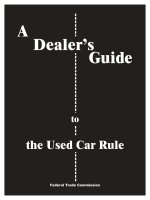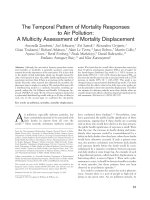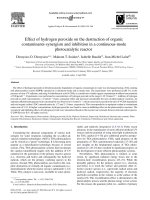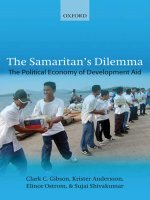- Trang chủ >>
- Khoa Học Tự Nhiên >>
- Vật lý
the undercover economist exposing why the rich are rich the poor are poor--and why you can never buy a decent used car nov 2005
Bạn đang xem bản rút gọn của tài liệu. Xem và tải ngay bản đầy đủ của tài liệu tại đây (2.42 MB, 289 trang )
THE UNDERCOVER ECONOMIST
This page intentionally left blank
THE
UNDERCOVER
ECONOMIST
Exposing Why The Rich Are Rich,
The Poor Are Poor—
And Why You Can Never Buy
A Decent Used Car!
Tim Harford
2006
Oxford University Press, Inc., publishes works that
further Oxford University’s objective of excellence
in research, scholarship, and education.
Oxford New York
Auckland Cape Town Dar es Salaam Hong Kong Karachi
Kuala Lumpur Madrid Melbourne Mexico City Nairobi
New Delhi Shanghai Taipei Toronto
With offices in
Argentina Austria Brazil Chile Czech Republic France Greece
Guatemala Hungary Italy Japan Poland Portugal Singapore
South Korea Switzerland Thailand Turkey Ukraine Vietnam
Copyright © 2006 by Tim Harford
Published by Oxford University Press, Inc.
198 Madison Avenue, New York, New York, 10016
www.oup.com
Oxford is a registered trademark of Oxford University Press
All rights reserved. No part of this publication may be reproduced,
stored in a retrieval system, or transmitted, in any form or by any means,
electronic, mechanical, photocopying, recording, or otherwise,
without the prior permission of Oxford University Press.
Library of Congress Cataloging-in-Publication Data
Harford, Tim, 1973–
The undercover economist / Tim Harford.
p. cm.
ISBN-13: 978-0-19-518977-3
ISBN-10: 0-19-518977-9
1. Economic history, 1990–
2. Economics.
3. Consumer education.
I. Title.
HC59.15.H35 2005 330.9'0511—dc22
2005010297
1 3 5 7 9 8 6 4 2
Printed in the United States of America
on acid-free paper
To Deborah Harford, Fran Monks, and Stella Harford—family
. . . past, present, and future.
This page intentionally left blank
Peter Sinclair got me into economics; Tony Courakis, Simon
Cowan, Stan Fischer, Bob Garhart, Paul Klemperer, Brendan
McElroy, Elinor Ostrom, Hyun Shin, Bill Sjostrom, and many
others helped me along the way. I am grateful to them all.
At Shell, Ged Davis let me work part-time while I produced
the first draft of the book. I was flattered by his reluctance and
grateful for his support. Other colleagues at Shell were inspira-
tional, especially Betty-Sue Flowers, Anupam Khanna, Cho
Khong, Michael Klein, Doug McKay, and John Robinson.
At the Financial Times, Pilita Clark, Andy Davis, Chris Giles,
Andrew Gowers, John Kay, John Willman, and Martin Wolf gave
me opportunities and then made sure I didn’t waste them.
At the World Bank, Michael Klein and Suzanne Smith are
wonderful colleagues and every day with them is an education.
David Bodanis, Felicity Bryan, Penny Dablin, Moore Flannery,
Juri Gabriel, Mark Henstridge, Diana Jackson, Oliver Johnson,
John Kay, Cho Khong, Paul Klemperer, Stephen McGroarty,
Doug McKay, Fran Monks, Dave Morris, Rafael Ramirez, Jillian
Reilly, John Robinson, Tim Savin, Martin Wolf, and Andrew
Wright improved the book with their comments.
Sally Holloway, my agent, has been superb. Tim Bartlett and
Kate Hamill at Oxford University Press infuriated me with their
precision and insight—I have been very lucky to work with them.
Acknowledgments
• vii •
Most importantly, emotional support came from Diana Jack-
son, my wife Fran Monks, “Uncle” Dave Morris, and Jillian Reilly.
Above all I have to thank Andrew Wright, a genius, without whom
the book could never have been finished, and David Bodanis, an
inspiration, without whom it would never have been started.
ACKNOWLEDGMENTS
• viii •
Introduction 1
ONE
Who Pays for Your Coffee? 5
TWO
What Supermarkets Don’t Want You to Know 31
THREE
Perfect Markets and the “World of Truth” 61
FOUR
Crosstown Traffic 79
FIVE
The Inside Story 109
SIX
Rational Insanity 137
SEVEN
The Men Who Knew the Value of Nothing 155
Contents
• ix •
• x •
CONTENTS
EIGHT
Why Poor Countries Are Poor 177
NINE
Beer, Fries, and Globalization 201
TEN
How China Grew Rich 231
Notes 253
Index 263
• xi •
CHAPTER TITLE
THE UNDERCOVER ECONOMIST
This page intentionally left blank
• 1 •
INTRODUCTION
Introduction
I would like to thank you for buying this book, but if you’re any-
thing like me you haven’t bought it at all. Instead, you’ve carried
it into the bookstore café and even now are sipping a cappuccino
in comfort while you decide whether it’s worth your money.
This is a book about how economists view the world. In fact,
there might be an economist sitting near you right now. You
might not spot him—a normal person looking at an economist
wouldn’t notice anything remarkable. But normal people look
remarkable in the eyes of economists. What is the economist
seeing? What could he tell you, if you cared to ask? And why
should you care?
You may think you’re enjoying a frothy cappuccino, but the
economist sees you—and the cappuccino—as players in an intri-
cate game of signals and negotiations, contests of strength and
battles of wits. The game is for high stakes: some of the people
who worked to get that coffee in front of you made a lot of money,
some of them made very little, and some of them are after the
money in your pocket right now. The economist can tell you who
will get what, how, and why. My hope is that by the time you
finish this book, you’ll be able to see the same things. But please
buy it first, before the store manager throws you out.
Your coffee is intriguing to the economist for another reason:
he doesn’t know how to make a cappuccino, and he knows that
• 2 •
THE UNDERCOVER ECONOMIST
nobody else does either. Who, after all, could boast of being able
to grow, pick, roast, and blend coffee, raise and milk cows, roll
steel and mold plastics and assemble them into an espresso ma-
chine, and, finally, shape ceramics into a cute mug? Your
cappuccino reflects the outcome of a system of staggering com-
plexity. There isn’t a single person in the world who could pro-
duce what it takes to make a cappuccino.
The economist knows that the cappuccino is the product of an
incredible team effort. Not only that, there is nobody in charge
of the team. Economist Paul Seabright reminds us of the pleas of
the Soviet official trying to comprehend the western system: “Tell
me . . . who is in charge of the supply of bread to the population
of London?” The question is comical, but the answer—nobody—
is dizzying.
When the economist drags his attention away from your cof-
fee and looks around the bookstore, the organizational challenges
are even greater. The complexity of the system that made the
store possible defies easy description: think of the accumulated
centuries of design and development, from the paper upon which
the books are printed to the spotlights that illuminate the shelves
to the software that keeps track of the stock, not to mention the
everyday miracles of organization through which the books are
printed, bound, stored, delivered, stacked, and sold.
The system works remarkably well. When you bought this
book—you have bought this book by now, haven’t you?—you
probably did so without having to give instructions to the book-
store to order it for you. Perhaps you did not even know when
you left your home this morning that you were going to buy it.
Yet by some magic, dozens of people took the actions necessary
to fulfill your unpredictable desires: me, my editors, marketers,
proofreaders, printers, paper manufacturers, ink suppliers, and
many others. The economist can explain how such a system works,
how companies will try to exploit it, and what you as a customer
can do to fight back.
Now the Undercover Economist is gazing out of the window
at the traffic jam outside. To some people, the jam is merely an
• 3 •
INTRODUCTION
irritating fact of life. To the economist, there is a story to tell
about the contrast between the chaos of the traffic and the smooth
running of the bookshop. We can learn something from the book-
store that will help us avoid traffic jams.
While economists are constantly thinking about the things
going on around them, they are not limited to discussing local
matters. If you cared to engage one in conversation you might
talk about the difference between bookshops in the developed
world and libraries in Cameroon, which have eager readers but
no books. You might point out that the gap between the world’s
rich countries and the world’s poor countries is huge and appall-
ing. The economist would share your sense of injustice—but he
could also tell you why rich countries are rich and poor countries
are poor, and what might be done about it.
Perhaps the Undercover Economist seems like a know-it-all,
but he reflects the broad ambition of economics to understand
people: as individuals, as partners, as competitors, and as mem-
bers of the vast social organizations we call “economies.”
This breadth of interest is reflected in the eclectic tastes of the
Nobel Prize committee. Since 1990, the Nobel Prize in Eco-
nomics has only occasionally been awarded for advances in the
obviously “economic” things, such as the theory of exchange rates
or business cycles. More often, it has been awarded for insights
less obviously connected with what you might have thought was
economics: human development, psychology, history, voting, law,
and even esoteric discoveries such as why you can’t buy a decent
secondhand car.
My aim in this book is to help you see the world like an econo-
mist. I will tell you nothing about exchange rates or business
cycles, but I will unlock the mystery of secondhand cars. We’ll
look at the big issues, such as how China is lifting a million people
a month out of poverty, and the little ones, such as how to avoid
paying too much money in the supermarket. It’s detective work
all the way, but I’ll teach you how to use the investigative tools of
the economist. I hope that by the end of the book, you’ll be a
more savvy consumer—and a more savvy voter too, able to see
• 4 •
THE UNDERCOVER ECONOMIST
the truth behind the stories that politicians try to sell you. Every-
day life is full of puzzles that many people do not even realize are
puzzles, so above all, I hope that you will be able to see the fun
behind these everyday secrets. So let’s start on familiar territory
by asking, who pays for your coffee?
• 5 •
WHO PAYS FOR YOUR COFFEE?
ONE
Who Pays for Your Coffee?
The long commute on public transportation is a commonplace
experience of life in major cities around the world, whether you
live in New York, Tokyo, Antwerp, or Prague. Commuting
dispiritingly combines the universal and the particular. The par-
ticular, because each commuter is a rat in his own unique maze:
timing the run from the shower to the station turnstiles; learning
the timetables and the correct end of the platform to speed up
the transfer between different trains; trading off the disadvan-
tages of standing room only on the first train home against a seat
on the last one. Yet commutes also produce common patterns—
bottlenecks and rush hours—that are exploited by entrepreneurs
the world over. My commute in Washington DC is not the same
as yours in London, New York, or Hong Kong, but it will look
surprisingly familiar.
Farragut West is the Metro station ideally positioned to serve
the World Bank, International Monetary Fund, and even the
White House. Every morning, sleep-deprived, irritable travelers
surface from Farragut West into the International Square plaza,
and they are not easily turned aside from their paths. They want
to get out of the noise and bustle, around the shuffling tourists,
and to their desks just slightly before their bosses. They do not
welcome detours. But there is a place of peace and bounty that
can tempt them to tarry for a couple of minutes. In this oasis,
• 6 •
THE UNDERCOVER ECONOMIST
rare delights are served with smiles by attractive and exotic men
and women—today, a charming barista whose name badge reads
“Maria.” I am thinking, of course, of Starbucks. The café is placed,
inescapably, at the exit to International Square. This is no quirk
of Farragut West: the first storefront you will pass on your way
out of the nearby Farragut North Metro is—another Starbucks.
You find such conveniently located coffee shops all over the planet
and catering to the same desperate commuters. The coffee shop
within ten yards of the exit from Washington’s Dupont Circle
Metro station is called Cosi. New York’s Penn Station boasts
Seattle Coffee Roasters just by the exit to Eighth Avenue. Com-
muters through Shinjuku Station, Tokyo, can enjoy a Starbucks
without leaving the station concourse. In London’s Waterloo
station, it is the AMT kiosk that guards the exit onto the south
bank of the Thames.
At $2.55 a tall cappuccino from Starbucks is hardly cheap. But of
course, I can afford it. Like many of the people stopping at that
café, I earn the price of that coffee every few minutes. None of us
care to waste our time trying to save a few pennies by searching
out a cheaper coffee at 8:30 in the morning. There is a huge
demand for the most convenient coffee possible—in Waterloo
Station, for example, seventy-four million people pass through
each year. That makes the location of the coffee bar crucial.
The position of the Starbucks café at Farragut West is advan-
tageous, not just because it’s located on an efficient route from
the platforms to the station exit, but because there are no other
coffee bars on that route. It’s hardly a surprise that they do a
roaring trade.
If you buy as much coffee as I do you may have come to the
conclusion that somebody is getting filthy rich out of all this. If
the occasional gripes in the newspapers are correct, the coffee in
that cappuccino costs pennies. Of course, the newspapers don’t
tell us the whole story: there’s milk, electricity, cost of the paper
cups—and the cost of paying Maria to smile at grouchy custom-
• 7 •
WHO PAYS FOR YOUR COFFEE?
ers all day long. But after you add all that up you still get some-
thing a lot less than the price of a cup of coffee. According to eco-
nomics professor Brian McManus, markups on coffee are around
150 percent—it costs forty cents to make a one-dollar cup of drip
coffee and costs less than a dollar for a small latte, which sells for
$2.55. So somebody is making a lot of money. Who?
You might think that the obvious candidate is Howard Schultz,
the owner of Starbucks. But the answer isn’t as simple as that.
The main reason that Starbucks can ask $2.55 for a cappuccino is
that there isn’t a shop next door charging $2.00. So why is no-
body next door undercutting Starbucks? Without wishing to dis-
miss the achievements of Mr. Schultz, cappuccinos are not in fact
complicated products. There is no shortage of drinkable
cappuccinos (sadly, there is no shortage of undrinkable cappuccinos
either). It doesn’t take much to buy some coffee machines and a
counter, build up a brand with a bit of advertising and some free
samples, and hire decent staff. Even Maria is replaceable.
The truth is that Starbucks’ most significant advantage is its
location on the desire line of thousands of commuters. There are
a few sweet spots for coffee bars—by station exits or busy street
corners. Starbucks and its rivals have snapped them up. If Star-
bucks really did have the hypnotic hold over its customers that
critics complain about, it would hardly need to spend so much
effort getting people to trip over its cafés. The nice margin that
Starbucks makes on their cappuccinos is due neither to the qual-
ity of the coffee nor to the staff: it’s location, location, location.
But who controls the location? Look ahead to the negotiations
for the new rental agreement. The landlord at International
Square will not only be talking to Starbucks but to other chains
like Cosi and Caribou Coffee, and DC’s local companies: Java
House, Swing’s, Capitol Grounds, and Teaism. The landlord
can sign an agreement with each one of them or can sign an
exclusive agreement with only one. She’ll quickly find that no-
body is very eager to pay much for a space next to ten other
coffee bars, and so she will get the most advantage out of the
exclusive agreement.
• 8 •
THE UNDERCOVER ECONOMIST
In trying to work out who is going to make all the money,
simply remember that there are at least half a dozen competing
companies on one side of the negotiating table and on the other
side is a landlord who owns a single prime coffee-bar site. By
playing them off against each other, the landlord should be able
to dictate the terms and force one of them to pay rent, which
consumes almost all their expected profits. The successful com-
pany will expect some profit but not much: if the rent looks low
enough to leave a substantial profit, another coffee bar will be
happy to pay a little extra for the site. There is an unlimited num-
ber of potential coffee bars and a limited number of attractive
sites—and that means the landlords have the upper hand.
This is pure armchair reasoning. It’s reasonable to ask if all of
this is actually true. After I explained to a long-suffering friend
(over coffee) all of the principles involved, she asked me whether
I could prove it. I admitted that it was just a theory—as Sherlock
Holmes might say, a piece of “observation and deduction,” based
on clues available to all of us. A couple of weeks later she sent me
an article from the Financial Times, which relied on industry ex-
perts who had access to the accounts of coffee companies. The
article began, “Few companies are making any money” and con-
cluded that one of the main problems was “the high costs of run-
ning retail outlets in prime locations with significant passing
trade.” Reading accounts is dull; economic detective work is the
easy way to get to the same conclusion.
Strength from scarcity
Browsing through the old economics books on the shelf at home,
I dug out the first analysis of twenty-first-century coffee bars.
Published in 1817, it explains not just the modern coffee bar
but much of the modern world itself. Its author, David Ricardo,
had already made himself a multimillionaire (in today’s money)
as a stockbroker, and was later to become a Member of Parlia-
ment. But Ricardo was also an enthusiastic economist, who longed
to understand what had happened to Britain’s economy during
• 9 •
WHO PAYS FOR YOUR COFFEE?
the then-recent Napoleonic wars: the price of wheat had rock-
eted, and so had rents on agricultural land. Ricardo wanted to
know why.
The easiest way to understand Ricardo’s analysis is to use one
of his own examples. Imagine a wild frontier with few settlers but
plenty of fertile meadow available for growing crops. One day an
aspiring young farmer, Axel, walks into town and offers to pay
rent for the right to grow crops on an acre of good meadow.
Everyone agrees how much grain an acre of meadow will pro-
duce, but they cannot decide how much rent Axel should pay.
Because there is no shortage of land lying fallow, competing land-
lords will not be able to charge a high rent . . . or any significant
rent at all. Each landlord would rather collect a small rent than
no rent at all, and so each will undercut his rivals until Axel is
able to start farming for very little rent—just enough to compen-
sate for the landlord’s trouble.
The first lesson here is that the person in possession of the
desired resource—the landlord in this case—does not always have
as much power as one would assume. And the story doesn’t specify
whether Axel is very poor or has a roll of cash in the false heel
of his walking boot, because it doesn’t make any difference to
the rent. Bargaining strength comes through scarcity: settlers
are scarce and meadows are not, so landlords have no bargain-
ing power.
That means that if relative scarcity shifts from one person to
another, bargaining shifts as well. If over the years many immi-
grants follow in Axel’s footsteps, the amount of spare meadow-
land will shrink until there is none left. As long as there is any,
competition between landlords who have not attracted any ten-
ants will keep rents very low. One day, however, an aspiring farmer
will walk into town—let’s call him Bob—and will find that there
is no spare fertile land. The alternative, farming on inferior but
abundant scrubland, is not attractive. So Bob will offer to pay
good money to any landlord who will evict Axel, or any of the
other farmers currently farming virtually rent-free, and let him
• 10 •
THE UNDERCOVER ECONOMIST
farm there instead. But just as Bob is willing to pay to rent mead-
owland rather than scrubland, all of the meadow farmers will
also be willing to pay not to move. Everything has changed, and
quickly: suddenly the landlords have acquired real bargaining
power, because suddenly farmers are relatively common and
meadows are relatively scarce.
That means the landowners will be able to raise their rents. By
how much? It will have to be enough that farmers earn the same
farming on meadows and paying rent, or farming on inferior scru-
bland rent free. If the difference in productiveness of the two
types of land is five bushels of grain a year, then the rent will also
be five bushels a year. If a landlord tries to charge more, his ten-
ant will leave to farm scrubland. If the rent is any less, the scrub
farmer would be willing to offer more.
It may seem odd that the rents changed so rapidly simply be-
cause one more man arrived to farm the area. This story doesn’t
seem to explain how the world really works. But there is more
truth to it than you might think, even if it is oversimplified. Of
course, in the real world, there are other elements to consider:
laws about evicting people, long-term contracts, and even cul-
tural norms, such as the fact that kicking one person out and
installing a new tenant the next day is just “not done.” In the real
world there are more than two types of farmland, and Bob may
have different options to being a farmer—he may be able to get a
job as an accountant or driving a cab. All these facts complicate
what happens in reality; they slow down the shift in bargaining
power, alter the absolute numbers involved, and put a brake on
sudden movements in rents.
Yet the complications of everyday life often hide the larger
trends behind the scenes, as scarcity power shifts from one group
to another. The economist’s job is to shine a spotlight on the
underlying process. We should not be surprised if, suddenly, the
land market shifts against farmers; or if house prices go up dra-
matically; or if the world is covered by coffee bars over a period
of just a few months. The simplicity of the story emphasizes one
• 11 •
WHO PAYS FOR YOUR COFFEE?
part of the underlying reality—but the emphasis is helpful in re-
vealing something important. Sometimes relative scarcity and
bargaining strength really do change quickly, and with profound
effects on people’s lives. We often complain about symptoms—
the high cost of buying a cup of coffee, or even a house. The
symptoms cannot be treated successfully without understanding
the patterns of scarcity which underlie them.
“Marginal” land is of central importance
The shifts in bargaining power don’t have to stop there. While
the farming story can be elaborated indefinitely, the basic prin-
ciples remain the same. For example, if new farmers keep arriv-
ing, they will eventually cultivate not only the meadowland but
also all of the scrubland. When a new settler, Cornelius, walks
into town, the only land available will be the grassland, which is
even less productive than scrubland. We can expect the same
dance of negotiations: Cornelius will offer money to landlords to
try to get onto scrubland, rents will quickly rise on scrubland,
and the differential between scrubland and meadow will have to
stay the same (or farmers would want to move), so the rent will
rise on meadow too.
The rent on meadowland, therefore, will always be equal to
the difference in grain yield between meadowland and whatever
land is available rent-free to new farmers. Economists call this
other land “marginal” land because it is at the margin between
being cultivated and not being cultivated. (You will soon see that
economists think about decisions at the margin quite a lot.) In
the beginning, when meadowland was more plentiful than set-
tlers, it was not only the best land, it was also the “marginal” land
because new farmers could use it. Because the best land was the
same as the marginal land, there was no rent, beyond the trivial
sum needed to compensate the landlord for his trouble. Later,
when there were so many farmers that there was no longer enough
prime land to go around, scrubland became the marginal land,
and rents on meadows rose to five bushels a year—the difference
• 12 •
THE UNDERCOVER ECONOMIST
in productivity between the meadowland and the marginal land
(in this case, the scrubland). When Cornelius arrived, the grass-
land became the marginal land, meadows became yet more at-
tractive relative to the marginal land, and so the landlords were
able to raise the rent on meadows again. It’s important to note
here that there is no absolute value: everything is relative to that
marginal land.
From meadows back to coffee kiosks
A nice story, but those of us who like Westerns may prefer the
gritty cinematography of Unforgiven or the psychological isola-
tion of High Noon. So, David Ricardo and I get no prizes for our
screenwriting, but we might be excused, as long as our little fable
actually tells us something useful about the modern world.
We can start with coffee kiosks. Why is coffee expensive in
London, New York, Washington, or Tokyo? The commonsense
view is that coffee is expensive because the coffee kiosks have to
pay high rent. David Ricardo’s model can show us that this is the
wrong way to think about the issue, because “high rent” is not an
arbitrary fact of life. It has a cause.
Ricardo’s story illustrates that two things determine the rent
on prime locations like meadowland: the difference in agricul-
tural productivity between meadows and marginal land, and the
importance of agricultural productivity itself. At a dollar a bushel,
five bushels of grain is a five-dollar rent. At two hundred thou-
sand dollars a bushel, five bushels of grain is a million-dollar rent.
Meadows command high dollar rents only if the grain they help
produce is also valuable.
Now apply Ricardo’s theory to coffee bars. Just as meadow-
land will command high rents if the grain they produce is valu-
able, prime coffee-bar locations will command high rents only if
customers will pay high prices for coffee. Rush-hour customers
are so desperate for caffeine and in such a hurry that they are
practically price-blind. The willingness to pay top dollar for con-
venient coffee sets the high rent, and not the other way around.









